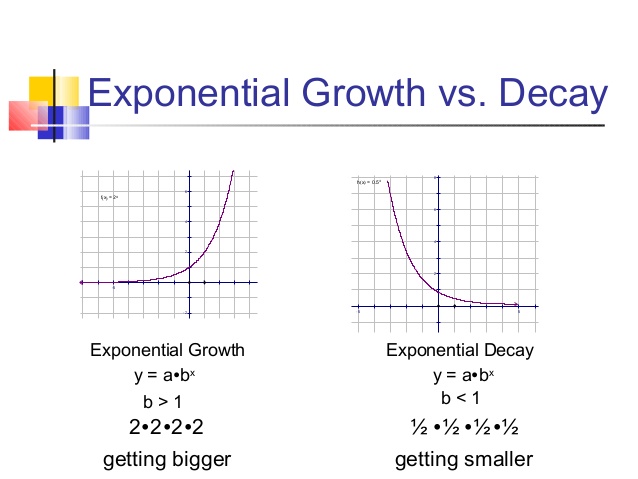Exponential Growth and Decay. Exponential growth can be amazing! Let us say we have this special tree.
It grows exponentially , following this formula ( e is Euler's number): Height (in mm) = e x. At 1 year old it is: e 1 = 2.7 mm high . really tiny! At 5 years it is: e 5 = 148 mm high . as high as a cup At 10 years: e 10 = 22 m high . as tall as a building At 15 years: e 15 = 3.3 km high . 10 times the height of the Eiffel Tower At 20 years: e 20 = 485 km high . up into space! No tree could ever grow that tall. So when people say "it grows exponentially" .
just think what that means.
Growth and Decay. But sometimes things can grow (or the opposite: decay) exponentially, at least for a while . So we have a generally useful formula: Where y(t) = value at time "t" a = value at the start k = rate of growth (when >0) or decay (when kt. We know a =3 mice, t=2 months, and right now y(2)=18 mice: Now some algebra to solve for k : The step where we used ln(e x )=x is explained more at Exponents
and Logarithms . Note: we can calculate k ≈ 0.896 , but it is best to keep it as k = ln(6)/2 until we do our final calculations. We can now put k = ln(6)/2 into our formula (also a=3): Now let's calclulate the population in 2 more months (at t=4 months): And in 1 year from now ( t=14 months): That's a lot of mice! I hope you will be feeding them properly. Exponential Decay. Some things "decay" (get smaller) exponentially.

Example: Atmospheric pressure (the pressure of air around you) decreases as you go higher. It decreases about 12% for every 1000 m: an exponential decay . The pressure at sea level is about 1013 hPa (depending on weather). Write the formula (with its "k" value), Find the pressure on the roof of the Empire State Building (381 m), and at the top of Mount Everest (8848 m) Start with the formula: a (the pressure at sea level) = 1013 hPa t is in meters (distance, not time, but the formula still works) y(1000) is a 12% reduction on 1013 hPa = 891.44 hPa. 891.44 = 1013 e k×1000. Now some algebra to solve for k : Now we know "k" we can write : y(t) = 1013 e (ln(0.88)/1000)×t. And finally we can calculate the pressure at 381 m , and at 8848 m : y( 381 ) = 1013 e (ln(0.88)/1000)× 381 = 965 hPa. y( 8848 ) = 1013 e (ln(0.88)/1000)× 8848 = 327 hPa. (In fact pressures at Mount Everest are around 337 hPa . good calculations!)






Комментариев нет:
Отправить комментарий